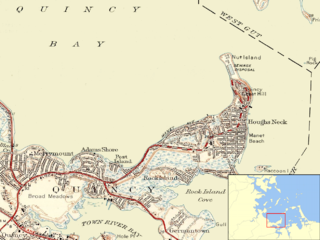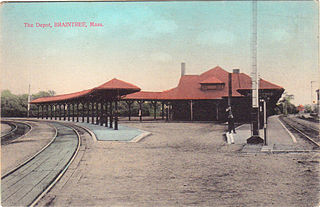
Quincy is a coastal U.S. city in Norfolk County, Massachusetts, United States. It is the largest city in the county and a part of Metropolitan Boston as one of Boston's immediate southern suburbs. Its population in 2020 was 101,636, making it the seventh-largest city in the state. Known as the "City of Presidents", Quincy is the birthplace of two U.S. presidents—John Adams and his son John Quincy Adams—as well as John Hancock and the first and third Governor of Massachusetts.

Braintree, officially the Town of Braintree, is a municipality in Norfolk County, Massachusetts, United States. Although officially known as a town, Braintree is a city, with a mayor-council form of government, and is considered a city under Massachusetts law. The population was 39,143 at the 2020 census. The city is part of the Greater Boston area with access to the MBTA Red Line, and is a member of the Metropolitan Area Planning Council's South Shore Coalition. The first mayor of Braintree was Joe Sullivan who served until January 2020. The current mayor of Braintree is Charles Kokoros.

The Massachusetts Water Resources Authority (MWRA) is a public authority in the Commonwealth of Massachusetts that provides wholesale drinking water and sewage services to certain municipalities and industrial users in the state, primarily in the Boston area.

Boston Harbor is a natural harbor and estuary of Massachusetts Bay, and is located adjacent to the city of Boston, Massachusetts. It is home to the Port of Boston, a major shipping facility in the Northeastern United States.

Biosolids are solid organic matter recovered from a sewage treatment process and used as fertilizer. In the past, it was common for farmers to use animal manure to improve their soil fertility. In the 1920s, the farming community began also to use sewage sludge from local wastewater treatment plants. Scientific research over many years has confirmed that these biosolids contain similar nutrients to those in animal manures. Biosolids that are used as fertilizer in farming are usually treated to help to prevent disease-causing pathogens from spreading to the public. Some sewage sludge can not qualify as biosolids due to persistent, bioaccumulative and toxic chemicals, radionuclides, and heavy metals at levels sufficient to contaminate soil and water when applied to land.

Bethlehem Steel Corporation Shipbuilding Division was created in 1905 when the Bethlehem Steel Corporation of Bethlehem, Pennsylvania, acquired the San Francisco shipyard Union Iron Works. In 1917 it was incorporated as Bethlehem Shipbuilding Corporation, Limited.

Fore River Shipyard was a shipyard owned by General Dynamics Corporation located on Weymouth Fore River in Braintree and Quincy, Massachusetts. It began operations in 1883 in Braintree, and moved to its final location on Quincy Point in 1901. In 1913, it was purchased by Bethlehem Steel, and later transferred to Bethlehem Shipbuilding Corporation. It was sold to General Dynamics in 1963, and closed in 1986. During its operation, yardworkers constructed hundreds of ships, for both military and civilian clients.

The Old Colony Railroad (OC) was a major railroad system, mainly covering southeastern Massachusetts and parts of Rhode Island, which operated from 1845 to 1893. Old Colony trains ran from Boston to points such as Plymouth, Fall River, New Bedford, Newport, Providence, Fitchburg, Lowell and Cape Cod. For many years the Old Colony Railroad Company also operated steamboat and ferry lines, including those of the Fall River Line with express train service from Boston to its wharf in Fall River where passengers boarded luxury liners to New York City. The company also briefly operated a railroad line on Martha's Vineyard, as well as the freight-only Union Freight Railroad in Boston. The OC was named after the "Old Colony", the nickname for the Plymouth Colony.

Braintree station is an intermodal transit station in Braintree, Massachusetts. It serves the MBTA's Red Line and the MBTA Commuter Rail Old Colony Lines as well as MBTA buses.

Milorganite is a brand of biosolids fertilizer produced by treating sewage sludge by the Milwaukee Metropolitan Sewerage District. The term is a portmanteau of the term Milwaukee Organic Nitrogen. The sewer system of the District collects municipal wastewater from the Milwaukee metropolitan area. After settling, wastewater is treated with microbes to break down organic matter at the Jones Island sewage treatment plant in Milwaukee, Wisconsin. The byproduct sewage sludge is produced. This is heat-dried with hot air in the range of 900–1,200 °F (482–649 °C), which heats the sewage sludge to at least 176 °F (80 °C) to kill pathogens. The material is then pelletized and marketed throughout the United States under the name Milorganite. The result is recycling of the nitrogen and phosphorus from the waste-stream as fertilizer. The treated wastewater is discharged to Lake Michigan.

Sewage sludge treatment describes the processes used to manage and dispose of sewage sludge produced during sewage treatment. Sludge treatment is focused on reducing sludge weight and volume to reduce transportation and disposal costs, and on reducing potential health risks of disposal options. Water removal is the primary means of weight and volume reduction, while pathogen destruction is frequently accomplished through heating during thermophilic digestion, composting, or incineration. The choice of a sludge treatment method depends on the volume of sludge generated, and comparison of treatment costs required for available disposal options. Air-drying and composting may be attractive to rural communities, while limited land availability may make aerobic digestion and mechanical dewatering preferable for cities, and economies of scale may encourage energy recovery alternatives in metropolitan areas.

Moon Island is an island in Quincy Bay, in the middle of Boston Harbor, Massachusetts. It is the location of the Boston Fire Department Training Academy, and Boston Police Department shooting range. All of the land on the island is owned by the City of Boston but the island is under the jurisdiction of Quincy, Massachusetts. It is also part of the Boston Harbor Islands National Recreation Area.

The Deer Island Waste Water Treatment Plant is located on Deer Island, one of the Boston Harbor Islands in Boston Harbor. The plant is operated by the Massachusetts Water Resources Authority (MWRA) and began partial operations in 1995. The facility was fully operational in 2000 with the completion of the outfall tunnel.

Quincy Point is a neighborhood of Quincy, Massachusetts. "The Point" is generally defined as the land east of Quincy Center, the downtown district. Quincy Point is bordered on the west by Elm Street, on the east by Weymouth Fore River and the Braintree city line, on the north by Town River and on the south by Quincy Avenue. The area altitude averages about 30 feet (9.1 m) above sea level. The population of this neighborhood in 2000 was 11,414.

Weymouth Fore River is a small bay or estuary in eastern Massachusetts and is part of the Massachusetts Bay watershed.

Nut Island is a former island in Boston Harbor, part of the Boston Harbor Islands National Recreation Area. The island has been connected through a short causeway to the end of Houghs Neck, becoming part of the mainland of Quincy, Massachusetts.

The South Shore Railroad was a railroad in Massachusetts. It was incorporated in 1846 to provide rail service between Quincy and Duxbury, Massachusetts through the towns of Hingham, Cohasset, Scituate and Marshfield.
William Brownell Golden is an American attorney and politician who represented the Norfolk and Plymouth district in the Massachusetts Senate from 1985 to 1991. He was a candidate for Lieutenant Governor of Massachusetts in 1990, but lost in the Democratic primary to Marjorie Clapprood.
The Thomas P. Smith Water Reclamation Facility (TPS) is owned and operated by the city of Tallahassee, Florida. The facility provides sewage treatment services for Tallahassee, Florida and the surrounding areas.

The Old Colony Street Railway Company was a horse-drawn and electric streetcar railroad operated on the streets of Boston, Massachusetts and communities south of the city. Founded in 1881 as the Brockton Street Railway Company, via lease and merger it became a primary mass transit provider for southeastern Massachusetts and Rhode Island. Its immediate successor was the Bay State Street Railway, and its modern successor is the state-run Massachusetts Bay Transportation Authority (MBTA).




















